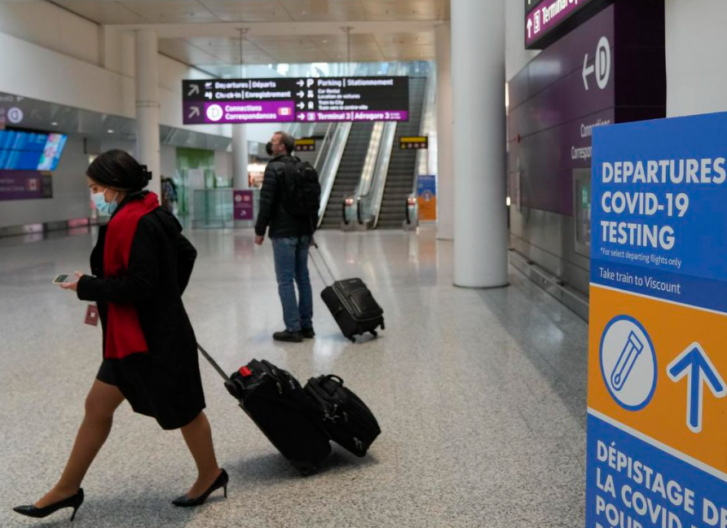OTTAWA—As COVID-19 cases tick upward around the globe and evidence mounts of the Omicron variant’s rapid spread, frustration is rising over the federal government’s attempts to keep the virus outside Canada’s borders.
Since Ottawa imposed its most recent travel ban — along with new testing and quarantine rules — confusion has plagued passengers in airports at home and abroad.
Travellers stuck overseas and those about to depart have descended on Facebook groups, begging for clarity over which rules they’re required to follow, amid questions about why tough new restrictions have been imposed on some countries but not others.
On Twitter, airlines have repeatedly deferred to the federal government when faced with flustered customers looking for help.
The federal government, in turn, keeps pointing to its website, which contains incomplete information.
Even cabinet ministers couldn’t seem to nail down their message: on Monday, Public Safety Minister Marco Mendicino told reporters Canada was trying to “buy” itself more time to learn about Omicron, while Transport Minister Omar Alghabra told CBC Radio the following morning that the country was working quickly on its approach.
The scramble has an echo of the early days of the pandemic — something experts say could have worrisome consequences nearly two years into the crisis.
“We’re at this point where people are already fed up and fatigued. Even some of the basic measures that we’ve asked for people to do — like masking in indoor settings, trying to reduce social contacts — it’s very hard to keep that up at this point,” said Dr. Susy Hota, medical director for infection prevention and control at Toronto’s University Health Network.

“If you lose people’s attention because one issue becomes really confusing, and the communications aren’t clear … we lose those same people for other things that are important to communicate during the emergence of a new variant.”
Much of the confusion began last week, when Ottawa banned foreign nationals who had recently travelled through 10 African countries from entering Canada.
The decision to bar some travellers but not others makes little sense given the rapid nature of Omicron’s spread, said Steven Hoffman, director of the Global Strategy Lab and a former project manager with the World Health Organization.
“Border closures are also great politics, because it puts the emphasis that this threat is from outside of the country and puts the blame on others, as opposed to putting blame on a country’s public health response to the challenge,” Hoffman told the Star.
His assessment of the strategy? “Good politics, not too great epidemiology.”
Canadians trying to leave those 10 countries were suddenly required to have a negative result from a molecular test for COVID-19 — and to have the test done in a third country — before they arrived back at home.
“That doesn’t seem to be a reasonable policy. Why can’t they have a PCR test where they’re at?” said Dr. Anna Banerji, an infectious disease specialist at the University of Toronto’s Dalla Lana School of Public Health.
“If they’re coming here and if they’re coming from a country with a lot of Omicron, then they could be tested here.”
(Travellers departing from South Africa got a slight reprieve on Saturday, with a temporary exemption that allows them to get tested there instead of in a third country. Health Canada told the Star that the exemption will be extended or revoked based on domestic and international epidemiology.)
Speaking to reporters on Tuesday, Alghabra rationalized the move as creating a “cushion” between travellers’ departures and their arrivals in Canada, to ensure a more accurate test result.
But even for travellers entering Canada from countries that aren’t on the banned list (aside from the United States), the rules can still be nebulous.
The Public Health Agency of Canada’s arrival plans for vaccinated and unvaccinated travellers — which include an arrival test, differing periods of quarantine, and followup tests — are not yet fully operational.
“The government is steadily increasing the number of fully vaccinated travellers being tested to reach fully 100 per cent operational capacity in the coming weeks,” Health Canada noted in an emailed statement.
Travellers are still not fully clear on where they obtain tests, how many must be completed and how long they are meant to quarantine, which all depends on where they’re coming from and their vaccination status.
What’s more, the government of Canada’s travel webpage notes that anyone who can show proof of a positive result from a COVID-19 test conducted between 14 and 180 days prior to departure is exempt from any arrival testing. But Health Canada contradicted that in its statement to the Star, saying that travellers arriving from the banned countries must undergo the testing — even if they’ve previously tested positive.
“We’re seeing some early evidence that out of South Africa that reinfections can occur more frequently with Omicron — two to three times more frequently than we’ve seen with other variants,” Hota said.
“Just because you’ve had a prior infection doesn’t mean that you are completely immune to an Omicron infection,” she said, adding that at the very least, those passengers should be asked to isolate given that testing recovered people can sometimes yield unreliable results.
Banerji says governments have been dealt a tricky task in coming up with new rules — and having to implement them.
“I think it’s challenging for any government to make policies with so much uncertainty and a lot of unknowns. I would say that it’s really important … to stick to the evidence and the science rather than an emotional response.”
Article From: The Star
Author: Raisa Patel

